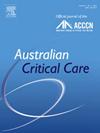应用健康老化脑保健监测仪对重症监护室转诊患者重症监护后综合征的潜在特征分类及影响因素:一项多中心队列研究
IF 2.7
3区 医学
Q2 CRITICAL CARE MEDICINE
引用次数: 0
摘要
重症监护后综合征(PICS)显著影响重症监护病房(ICU)转移患者,造成长期的身体、认知和心理后果。然而,针对这些患者全谱症状的个性化干预措施仍然有限。目前主流的PICS评估方法涉及多种量表,可能很复杂,而健康老龄化脑保健监测仪提供了一种更精简的方法来评估icu转移患者的全方位症状;因此,其在这一人群中的应用需要进一步探索。目的应用健康老化脑保健监护仪对icu转院患者PICS症状的严重程度进行分类,并探讨不同PICS严重程度的影响因素。方法采用队列研究方法,于2023年1 - 12月在北京市四家三级医院进行icu转院患者的研究。使用纸质问卷收集数据,并使用Mplus 8.3 (muthsamn & muthsamn, Los Angeles, CA, USA)进行潜在特征分析,对PICS严重程度进行分类。采用卡方检验、Kruskal-Wallis检验和逻辑回归分析组间差异。结果隐性特征分析可将PICS症状分为三类:“轻度PICS组”(48.95%)、“中度PICS组”(28.69%)和“重度PICS组”(22.36%)。Logistic回归分析显示,受教育程度(小学及以下,比值比[or] = 3.129, 95%可信区间[CI]: 1.182 ~ 6.985)、急性生理与慢性健康评估II评分(or = 1.100, 95% CI: 1.016 ~ 1.190)、序贯器官衰竭评估评分(or = 1.312, 95% CI: 1.110 ~ 1.552)、医院焦虑与抑郁量表抑郁评分(or = 1.721, 95% CI: 1.220 ~ 2.426)等因素显著影响PICS出现严重症状的可能性。结论:本研究揭示了icu转移患者PICS严重程度的不同特征,强调了基线健康、焦虑和转移部门在决定症状严重程度方面的重要作用。这些发现突出了基于这些特征的个性化、针对性干预措施的潜力。未来的研究应探讨这些因素如何相互作用及其因果关系,以更好地定制干预措施,提高ICU出院后的恢复和生活质量。本文章由计算机程序翻译,如有差异,请以英文原文为准。
Application of the healthy aging brain care monitor for latent profile classification and influencing factors of post–intensive care syndrome in intensive care unit–transferred patients: A multicentre cohort study
Background
Post–intensive care syndrome (PICS) significantly impacts intensive care unit (ICU)–transferred patients, causing long-term physical, cognitive, and psychological consequences. However, personalised interventions targeting the full spectrum of symptoms in these patients remain limited. Current mainstream PICS assessment methods involve multiple scales, which can be complex, whereas the Healthy Aging Brain Care Monitor offers a more streamlined approach for evaluating the full range of symptoms in ICU-transferred patients; thus, its application in this population requires further exploration.
Objectives
The objectives of this study were to classify the severity of PICS symptoms in ICU-transferred patients using the Healthy Aging Brain Care Monitor and to identify influencing factors associated with different PICS severity categories.
Methods
A cohort study was conducted at four tertiary hospitals in Beijing from January to December 2023, enrolling ICU-transferred patients. Data were collected using paper-based questionnaires, and a latent profile analysis was performed using Mplus 8.3 (Muthén & Muthén, Los Angeles, CA, USA) to classify PICS severity. Differences between groups were analysed using chi-squared tests, Kruskal–Wallis tests, and logistic regression.
Results
The latent profile analysis identified three categories of PICS symptoms: “mild PICS group” (48.95%), “moderate PICS group” (28.69%), and “severe PICS group” (22.36%). Logistic regression analysis showed that factors such as education level (primary school or below, odds ratio [OR] = 3.129, 95% confidence interval [CI]: 1.182–6.985), Acute Physiology and Chronic Health Evaluation II score (OR = 1.100, 95% CI: 1.016–1.190), Sequential Organ Failure Assessment score (OR = 1.312, 95% CI: 1.110–1.552), and Hospital Anxiety and Depression Scale for depression score (OR = 1.721, 95% CI: 1.220–2.426) significantly influenced the likelihood of severe PICS symptoms.
Conclusions
The study revealed distinct PICS severity profiles in ICU-transferred patients, emphasising the significant role of baseline health, anxiety, and department of transfer in determining symptom severity. These findings highlight the potential for personalised, targeted interventions based on these profiles. Future research should explore how these factors interact and their causal relationships to better tailor interventions for improving recovery and quality of life post ICU discharge.
求助全文
通过发布文献求助,成功后即可免费获取论文全文。
去求助
来源期刊

Australian Critical Care
NURSING-NURSING
CiteScore
4.90
自引率
9.10%
发文量
148
审稿时长
>12 weeks
期刊介绍:
Australian Critical Care is the official journal of the Australian College of Critical Care Nurses (ACCCN). It is a bi-monthly peer-reviewed journal, providing clinically relevant research, reviews and articles of interest to the critical care community. Australian Critical Care publishes peer-reviewed scholarly papers that report research findings, research-based reviews, discussion papers and commentaries which are of interest to an international readership of critical care practitioners, educators, administrators and researchers. Interprofessional articles are welcomed.
 求助内容:
求助内容: 应助结果提醒方式:
应助结果提醒方式:


